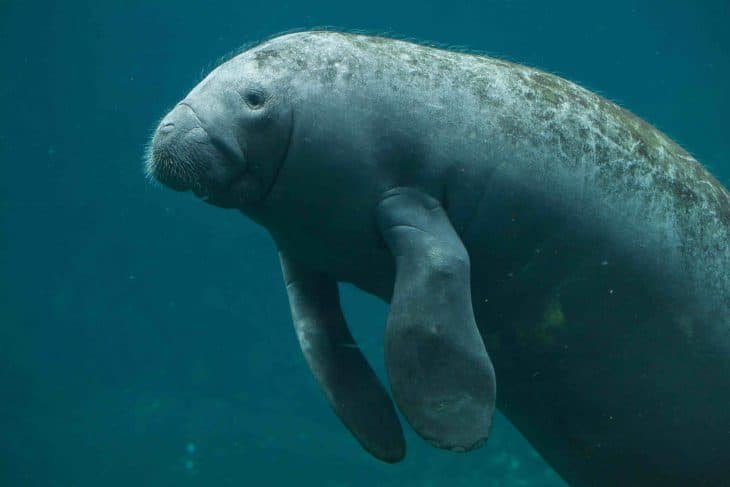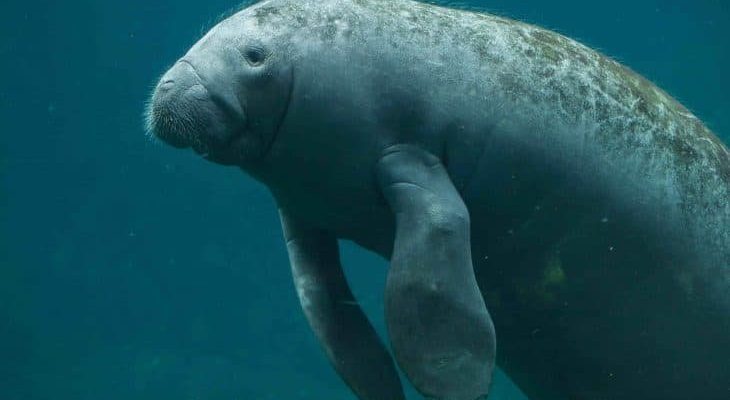
In this article, we’ll dive into some remarkable facts about manatees that may surprise you. Whether you’re a marine biology enthusiast or just curious about these docile mammals, there’s a lot to discover. So, grab your favorite drink, sit back, and let’s explore the captivating world of manatees together!
1. Manatees Are Herbivores
You might be surprised to learn that manatees are strict herbivores, which means they primarily eat plants. These gentle giants feast mainly on seagrasses, aquatic plants, and algae. In fact, a manatee can consume up to 10% of its body weight in plants each day! That’s like you eating 20 pounds of salad in a single sitting.
Manatees have flat, molar-like teeth that help grind up the plants they consume. As they munch their way through the underwater vegetation, they play a crucial role in maintaining healthy seagrass beds. These beds are vital for various marine life, offering shelter and food. So, next time you see a manatee, remember they’re not just floating around—they’re making a real difference in their ecosystem!
2. They Can Hold Their Breath for a Long Time
Manatees are mammals, just like us, which means they need to breathe air. However, they can hold their breath for about 15 to 20 minutes while submerged. Picture yourself diving underwater; most of us can hold our breath for maybe a minute or two. Manatees, on the other hand, are quite the champions!
Here’s how they do it: when they dive, their heart rate slows down, which helps conserve oxygen. This adaptation allows them to explore the underwater world effectively. They typically surface every few minutes to breathe, but when they’re in a relaxed state, they can stay underwater for quite a while. Isn’t that impressive?
3. They Have a Unique Swimming Style
Manatees may look a bit clumsy when they swim, but they have a graceful way of moving through the water. They use their strong, paddle-like tails to propel themselves and steer using their front flippers. It’s almost like they’re cruising through a serene underwater ballet, albeit a slow one.
Interestingly, manatees can swim at speeds up to 15 miles per hour in short bursts. However, they prefer to take their time, typically cruising at around 3 to 5 miles per hour. This leisurely pace allows them to enjoy their surroundings—whether it’s floating along with the current or grazing on underwater plants.
4. Manatees Are Social Creatures
You might think of manatees as solitary animals, but they can actually be quite social! They often gather in groups, especially in warmer waters, where they can enjoy social interactions. These social gatherings are called herds, and they often consist of mothers and their calves, as well as other adults.
Manatees communicate with each other using a variety of sounds, including chirps, whistles, and squeaks. It’s fascinating to think that these gentle giants have a “language” of their own. They can also demonstrate affection toward one another through gentle nudges and touches—definitely heartwarming behavior!
5. They Have a Slow Reproduction Rate
Manatees are slow to reproduce, which poses a challenge for their populations. Females typically give birth every two to five years, and they usually have just one calf at a time. The gestation period lasts around 12 months, similar to humans. This means that manatee populations can take a long time to recover if they face significant threats.
Once a calf is born, it stays close to its mother for up to two years, learning essential survival skills. During this period, the mother provides protection and teaches the calf how to find food and navigate its environment. It’s a touching reminder of the strong bond between a mother and her young.
6. Manatees Are Endangered
Sadly, manatees face several threats that have led to their endangered status. Habitat loss, boat strikes, and climate change are significant risks for these gentle giants. They depend on seagrass beds, which are increasingly threatened by pollution and coastal development.
Boating accidents can also be fatal for manatees, as they often swim in shallow waters. Educating boaters about slow speeds in manatee habitats is crucial for their safety. Conservation efforts are ongoing, aimed at creating safe environments for these creatures and helping their populations recover.
7. Manatees Have a Unique Skin
Have you ever touched the skin of a manatee? It’s quite unique! Their skin is thick and tough, with a texture similar to that of a rubber tire. This tough exterior protects them from both abrasions and parasites. Interestingly, as manatees age, they tend to develop areas of wrinkled skin, often referred to as “manatee wrinkles.”
Their skin is also fascinating because it can be grayish-brown and is covered with small hair-like structures called vibrissae. These bristles are sensitive and help manatees feel their environment. It’s like they have built-in sensors to help them navigate through their watery habitat.
8. They Have Excellent Hearing
Manatees may not have the best vision, but they compensate for it with a keen sense of hearing. They rely heavily on sounds to communicate and navigate their surroundings. Their ears, although small, are perfectly adapted to detect a variety of underwater noises.
This ability is vital for survival, especially in murky waters where visibility is low. Manatees can use their excellent hearing to detect the sounds of approaching boats, other marine life, and even potential threats. So, while they might look like gentle giants floating around, they’re quite alert!
9. Manatees Can Be Found in Various Locations
While manatees are often associated with Florida’s warm waters, they can actually be found in several regions. They inhabit shallow coastal areas, rivers, and freshwater springs in the Caribbean, Central America, and even parts of Africa. This wide-ranging habitat showcases their adaptability, as they thrive in both salty and freshwater environments.
During the colder months, manatees migrate to warmer waters to avoid chilly temperatures. It’s a bit like how we seek sunshine during winter! Understanding their migration patterns helps conservationists protect these gentle creatures and ensure they have access to suitable habitats year-round.
10. They Are Part of a Unique Family
Manatees belong to a unique group of marine mammals known as sirenids, which also includes dugongs. They are more closely related to elephants than to other marine mammals like dolphins or whales. That might sound surprising at first, but it emphasizes how diverse and interconnected life on Earth can be.
This unique classification enriches our understanding of marine ecosystems. The more we learn about manatees and their relatives, the better equipped we become to help protect these incredible animals and their habitats.
In conclusion, manatees are truly fascinating creatures with unique characteristics and behaviors. Whether they’re munching on seagrass, socializing with one another, or gracefully gliding through the water, they remind us of the importance of preserving our oceans. So, next time you spot a manatee, take a moment to appreciate this gentle giant and the role it plays in our natural world.

